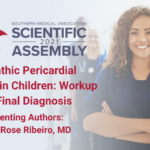Abstract | November 9, 2021
Idiopathic Pericardial Effusions in Children: Workup and Final Diagnosis
Learning Objectives
- Discuss common causes of pericardial effusions in children.
- Identify if there are etiologic diagnoses for patients initially diagnosed with idiopathic pericardial effusions.
- Identify workup performed for patients with idiopathic pericardial effusions.
Background: Pericardial effusions have a wide range of causes, with etiology typically guiding treatment. However, etiology can be difficult to determine, and workup for pediatric pericardial effusions is not standardized. Because idiopathic pericardial effusions are often presumed to be viral, a complete workup may not be pursued.
Some idiopathic effusions later receive an etiologic diagnosis and may experience a delay in definitive treatment. Systematic workup of adults with idiopathic pericardial effusions has been shown to be efficient in determining etiologic diagnoses, but there are no similar studies in children.
The workup for pediatric pericardial effusions is not standardized and effusions that are diagnosed as idiopathic may have a treatable etiologic diagnosis.
Methods: A system-wide retrospective chart review of children (<18 years) was conducted using ICD-9 and 10 codes for pericardial effusion (1/1/1990-10/1/2019). Effusions were grouped by diagnostic category. The idiopathic effusions were analyzed to define the workup and final etiologic diagnoses.
Results: There were 367 children with pericardial effusions identified and 52/367 effusions (14%) were labeled idiopathic. Readmission was required for 15/52 (29%) idiopathic effusions, with median hospital length of stay of 5 days. 5/52 (10%) required >2 admissions.
Eventual etiologic diagnosis was found in 14/52 (27%) patients. The most common diagnoses were autoimmune (7/14, 50%), neoplastic (4/14, 29%), infectious (2/14, 14%), and renal (1/14, 7%).
Workup was non-standard but commonly included complete blood count (46/52, 88%) and electrolytes (48/52, 92%). Other studies included rheumatologic (27/52, 52%) and thyroid (22/52, 42%).
Most patients (41/52, 79%) had eventual resolution of effusion within a median of 1 admission (range 1-4).
Conclusions: More than a quarter of children diagnosed with an idiopathic pericardial effusion have an etiologic diagnosis—most commonly autoimmune-related. Though most effusions resolved, nearly 30% required readmission prior to definitive treatment and resolution. A systematic diagnostic approach could facilitate earlier treatment and value-based care. Future studies should evaluate healthcare costs for workup and treatment of pediatric pericardial effusions.

